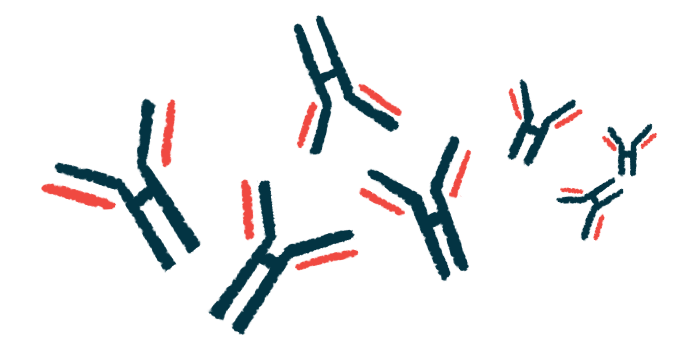Autoantibodies seen in blood years before MS diagnosis: Study
Researchers find profile of self-reactive antibodies in 10% of patients

Researchers have identified a distinct profile of self-reactive antibodies that appear in the blood years before the first clinical signs of multiple sclerosis (MS), which they believe could be used to help diagnose the neurodegenerative disease.
The antibodies were found in about 10% of people who developed MS and were basically 100% predictive of an MS diagnosis. They targeted a protein sequence that’s similar to one seen on common pathogens that infect humans, including the Epstein-Barr virus (EBV) that’s recently been identified as a leading risk factor for MS.
“Over the last few decades, there’s been a move in the field to treat MS earlier and more aggressively with newer, more potent therapies,” Michael Wilson, MD, professor at the University of California San Francisco (UCSF) and a senior author on the study, said in a university press release. “A diagnostic result like this makes such early intervention more likely, giving patients hope for a better life.”
The study, “An autoantibody signature predictive for multiple sclerosis,” was published in Nature Medicine.
In MS, the immune system launches mistaken attacks on myelin, a fatty substance that surrounds and protects nerve cells. These immune attacks are in part driven by the production of self-reactive antibodies, or autoantibodies, from immune B-cells.
Pinpointing a signature
While researchers have previously identified specific autoantibodies that are present in some autoimmune diseases years before symptom onset, and can thus be used to help with a diagnosis, “no such validated diagnostic autoantibodies exist” in MS, the researchers wrote.
To pinpoint an MS-specific autoantibody signature, a team of scientists at UCSF and colleagues at other U.S. institutions examined blood samples from the U.S. Department of Defense Serum Repository, which holds samples from more than 10 million armed services members.
The researchers examined blood from 250 MS patients, including their earliest sample taken at the time they entered active duty — an average of five years before their first clinical symptoms of MS — and another sample collected an average of 1.2 years after their first disease attack. Samples were also collected from 250 healthy veterans who hadn’t developed MS.
Results showed that about 10% of MS patients had a specific autoantibody profile in their blood that was evident years before they started having MS symptoms. The profile was preserved over time, still evident in blood samples collected after their diagnosis.
The self-reactive antibodies appeared to be targeting a protein sequence that’s highly similar to ones seen across common human pathogens, including the hepatitis C virus, Escherichia coli and Pseudomonas aeruginosa bacteria, and EBV.
Neurofilament light chain (NfL), a biomarker of nerve damage, was also elevated in MS patients before clinical disease onset, and was particularly higher in patients with the common autoantibody profile.
The scientists validated their findings in a group of people from a separate study who had blood samples taken at the time of their first neurological symptom attack, a period close to the time of diagnosis. This included 104 people ultimately diagnosed with MS and 14 for whom MS was ultimately ruled out.
Again, about 10% of people diagnosed with MS had a similar autoantibody profile as that observed in the military population.
Across both groups, this profile was found to be highly specific for MS, with nearly every person positive for it being diagnosed with the disease.
When patients ‘stop looking like snowflakes’
“When we analyze healthy people using our technology, everybody looks unique, with their own fingerprint of immunological experience, like a snowflake,” said Joe DeRisi, PhD, a UCSF professor and a senior study author. “It’s when the immunological signature of a person looks like someone else, and they stop looking like snowflakes that we begin to suspect something is wrong, and that’s what we found in these MS patients,” DeRisi added.
It still is not known what instigates these immune responses in the patients who develop them, but the researchers believe that prior infection with EBV or other common pathogens is likely key.
They noted that it will be important to “elucidate the precise origins” of this particular MS signature. For the remaining 90% of patients who don’t develop this autoantibody profile, the mechanisms underlying disease development also remain to be unraveled.
Still, the scientists believe the current findings offer a definitive indicator of MS, at least for a subset of patients, that can be used to help identify high-risk patients before symptoms are evident.
“Imagine if we could diagnose MS before some patients reach the clinic,” said senior study author Stephen Hauser, MD, also a UCSF professor. “It enhances our chances of moving from suppression to cure.”








